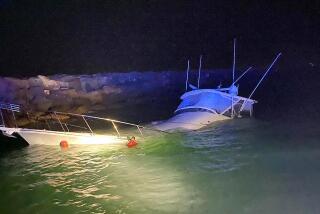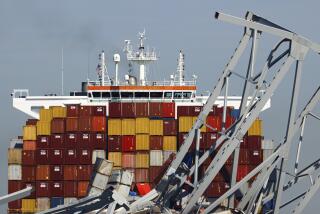Reverse-thrust controls on ferry failed, captain tells NTSB
- Share via
NEW YORK -- The captain of a commuter ferry that slammed into a Manhattan dock, leaving two passengers with critical head injuries, told investigators Thursday that the controls that are supposed to slow the boat failed as it approached the pier.
The 36-year-old captain described a harrowing few seconds before the impact at Pier 11 on Wednesday, as the Seastreak Wall Street arrived in Lower Manhattan after leaving New Jersey about 45 minutes earlier. It carried 326 passengers and five crew members, and National Transportation Safety Board investigators interviewed all the crew Thursday.
At a briefing, NTSB spokesman Robert Sumwalt gave a detailed account of the captain’s movements before the crash, saying he followed standard procedure by moving from the 140.7-foot catamaran’s central control console to a starboard bridge wing as he neared the dock. Controls at the starboard wing are used to activate a reverse thrust, slowing the boat down as the captain guides it into place.
“But the vessel did not respond as anticipated” when the captain tried to activate the reverse thrust, said Sumwalt. The captain then rushed back to the central control console, about 12 feet away, and found that those controls also were not working, Sumwalt said. At about the same time, both diesel engines shut down.
The effect of the failed reverse thrust was to send the boat moving too quickly toward the pier, where it hit one slip, then continued and slammed into a second slip. Passengers who were standing at the front of the boat preparing to disembark were thrown to the ground, against the glass windows, and in one case down a flight of stairs. A total of 57 were injured.
“Each of these crew members are shaken and very concerned about the accident,” said Sumwalt, who said investigators spent more than three hours talking to the captain Thursday. He has not been named, but Sumwalt said he had 17 years’ experience on ferries, 12 of them as a captain. On the day of the crash, he was rested and was working his usual schedule, which began with a 6 a.m. castoff from New Jersey for the first round trip of the day to New York City. The crash occurred on the second run.
Blood tests performed on the captain and crew showed no sign of alcohol, Sumwalt said. It will take longer to get results from tests for drugs.
Sumwalt said the boat’s engineer was still being interviewed but that his first language is Burmese, so police had provided a translator. The NTSB also asked witnesses who might have been on the dock and seen the boat as it approached to email them video, photographs or information that might help determine what happened. The address is [email protected].
Investigators plan to test out the boat’s control and navigation system themselves as they try to determine the cause of New York’s third serious ferry crash in the past decade. The other two involved the Staten Island Ferry, and the worst occurred in 2003 when a ferry operator fell asleep at the controls and slammed his boat into a dock. That crash killed 11 people.
According to Sumwalt, the captain said the Seastreak Wall Street’s steering and rudder system continued to operate properly even as other controls failed.
The boat underwent a major mechanical renovation last summer that replaced its original propulsion system with propellers to make it more fuel-efficient. Sumwalt has said the overhaul, which included gutting much of the ship’s interior and major work in the hull, is one thing investigators will study as they search for the cause of the crash.
ALSO:
Outbreak has officials bracing for worst flu season in years
Arizona legislator targets fake Twitter and Facebook accounts
Oregon bus crash involved ‘black ice’ conditions, lawyer says
More to Read
Sign up for Essential California
The most important California stories and recommendations in your inbox every morning.
You may occasionally receive promotional content from the Los Angeles Times.











